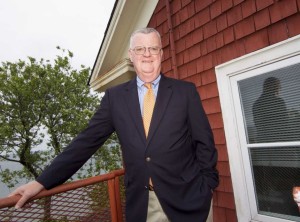Wading River retreat house was FBI disinformation operation in World War II
Originally published: Newsday, May 31, 2014
By robert.kessler@newsday.com
Article as it appeared in print: Newsday-Spies-Next-Door-1JUN14 (.pdf)

These days, Benson House, located on a scenic, waterfront bluff 150 feet above Long Island Sound in Wading River, is a retreat house and office on the grounds of the Episcopal diocese’s Camp DeWolfe.
But during World War II, the three-story house was a highly secret — and still now mostly unheralded — FBI radio transmission location.
From there, between 1942 and 1945, FBI agents pretending to be Nazi spies in the United States transmitted false information to German Army intelligence headquartered in Hamburg. The agents also learned what the German high command was thinking and planning, based on questions the “spies” were tasked to answer.
In commemoration of the 70th anniversary of the Normandy invasion, the Society of Former Special Agents of the FBI is planning to unveil a plaque at the house on Saturday, June 7, at 10:30 a.m. to finally widely publicize the building’s historic wartime roles, which included helping to deceive the Nazis about where the Allied invasion of Western Europe was to take place. (See Event Details)
While the Normandy landing occurred June 6, 1944, officials said the ceremony will take place the following day, a Saturday, because it is the most convenient for the several hundred former agents and World War II veterans from Long Island and nationwide who are expected to attend.
During the war, the FBI “spies” at Benson House reported back a stream of information that created two phantom Allied armies, one in Scotland that was supposedly planning to invade Norway, and one in southeastern England aiming to land at the Pas de Calais, northeast of Normandy, according to a new book written by Raymond J. Batvinis.

The FBI agents transmitted false information from real Nazi spies who, unbeknownst to Germany, had turned themselves in and were cooperating with the FBI, Batvinis says.
Batvinis grew up in East Islip, and his parents worked at the state psychiatric hospital in adjacent Central Islip. He is a former senior FBI counterintelligence agent who retired from the bureau in 1997, then went on to earn a doctorate in history and is now a professor at George Washington University.
Surprisingly very little has ever been written about Benson House, but its operation is featured in Batvinis’ newly published book about the FBI’s longtime leader and the bureau’s fight against Nazi agents in the United States, “Hoover’s Secret War Against Axis Spies.”
In addition to its role in the Normandy deception, the FBI’s “Nazi spies” also helped persuade the United States to go ahead with the development of the atomic bomb because the Germans were working on the same project, according to Batvinis’ more than six years of research that included FBI records from the time.
Batvinis says the agents also helped divert Japanese resources and attention from the U.S. plans in the Pacific both to invade the Marshall and Gilbert Islands and Okinawa.
The false information from Benson House indicated that the United States planned instead to invade the Kuril Islands, northeast of Japan, and Formosa, which was passed from Germany to Japan.
German intelligence was continuously asking the agents to obtain information about “experiments performed in the United States relative to the shattering of atoms” and told them the German army was anxious to develop high explosives from atoms, Batvinis says.
Benson House was not the only source of information that both helped persuade the United States to go ahead with the bomb’s development and deceive Germany and Japan. But it played a large, if until now, unsung role, Batvinis says.
The isolation of Benson House — named later after Mary Benson, who donated money to the diocese to buy the property after the war — was one of the reasons it was selected for the secret transmission station.
To further conceal its operation, the FBI moved into the ground floor of the house a “tubercular” looking agent, Donworth Johnson, his wife, Betty Ann, and their then 2-year-old daughter, Vicki Jean.
The idea was that Johnson, who was actually healthy, could say to any curious neighbors in the sparsely populated area that he was too sickly to be in the military, according to Batvinis and Vicki Jean Johnson, in a recent interview.
The radio operators lived and worked on the second and third floors, and came and went at night.
The basement had an electric generator to provide power to the overseas radio transmitters, in order to avoid running up high electric utility bills, and a large muffler concealed the sound of the generator, Batvinis said.
Security was also provided by an FBI guard dog named Clifford, who became a very special agent one day, the now 73-year-old Johnson recalled her late mother telling her.
Wearing only a diaper, 2-year-old Johnson had wandered the few feet from the back of the house to the edge of the high bluff and was about to fall over.
But Clifford grabbed her by the diaper and carried her back to the house, Johnson said.

PHOTO GALLERY (Click to enlarge)












You must be logged in to post a comment.